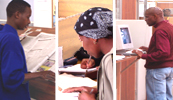
| Dewey Decimal Classification (DDC) |
 |




Searching techniques:
Information finding tools:
Example
Information sources:
Let's look at the following example:
The book Bank management and regulation: a book of readings by Anthony Saunders can be found on the shelf at 333.1068 SAV.
This number, 332.1068 SAV is the call number (shelf number) that can be found on the spine (back) of the book.
Let's look at the number 332.1068 SAV by breaking it down:
 |
 |
 |
 |
 |
| 332 | This part of the number indicates the main class number, consisting of three digits. In this case 330 is the main class for Economics and 332 is Financial Economics, which forms part of that main class. | |||
 |
 |
 |
 |
 |
| . | The main class number is followed by a decimal point. | |||
 |
 |
 |
 |
 |
 |
1068 |  |
The decimal point indicates sub-divisions of the main class. |  |
 |
 |
 |
 |
 |
 |
SAV |  |
The sub-division number is followed by three alphabetical letters (normally the first three letters of the author's name or the title of the book). |  |
 |
 |
 |
 |
 |
 |
 |
 |
 |
 |
You should understand the order of books with such numbers.
 |
 |
 |
 |
 |
 |
 |
 |
332.112 SAV | is before | 333.112 SAV | |||
 |
 |
 |
 |
 |
 |
 |
 |
332.1068 SAV | is after | 332.1068 | |||
 |
 |
 |
 |
 |
 |
 |
 |
306.4812 BAN |  |
is before |  |
491.77 TAN |  |
 |
 |
 |
 |
 |
 |
 |
Note: Sometimes there are codes before the actual number, e.g. REF, B, etc. These indicate collections or branches.
